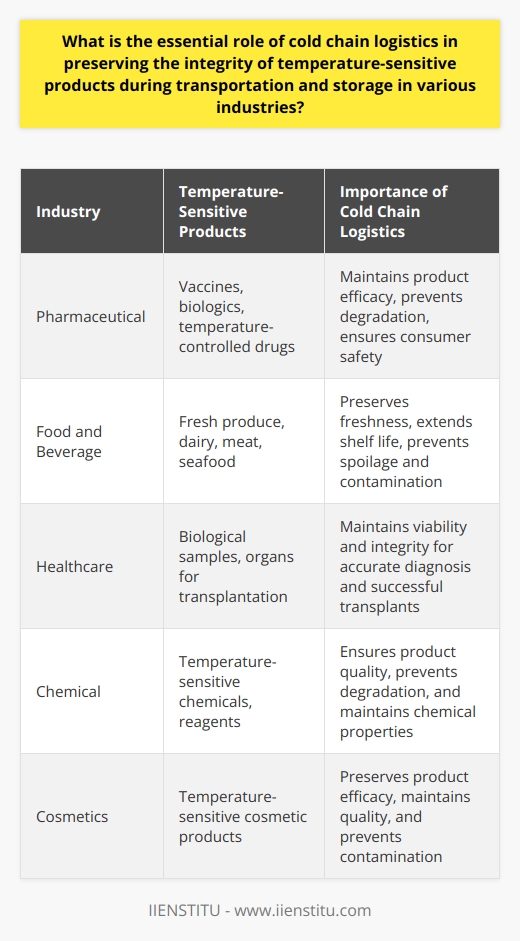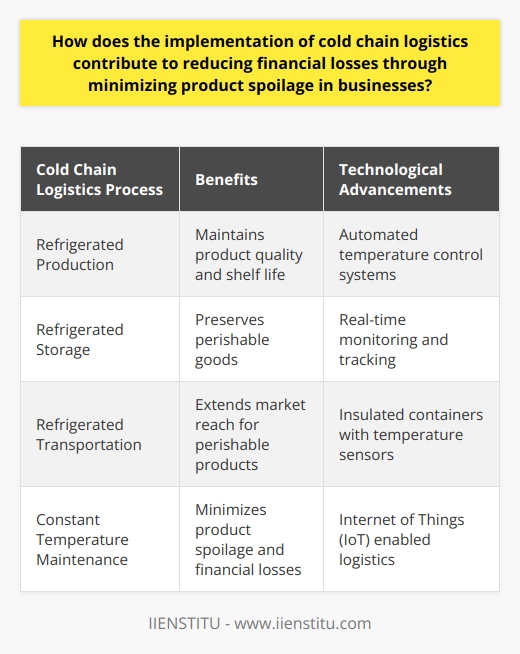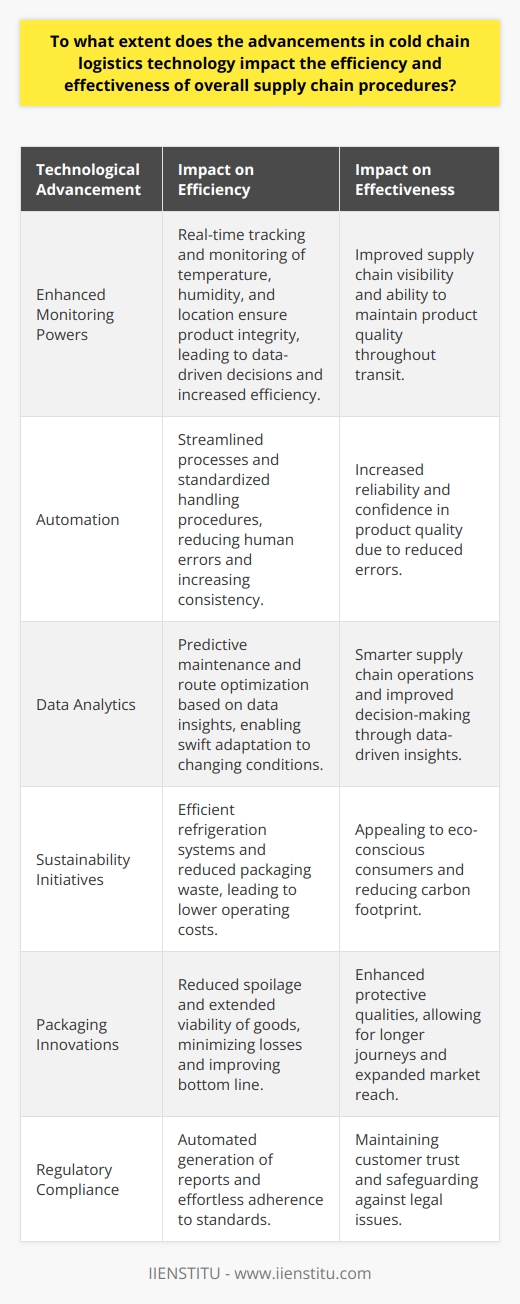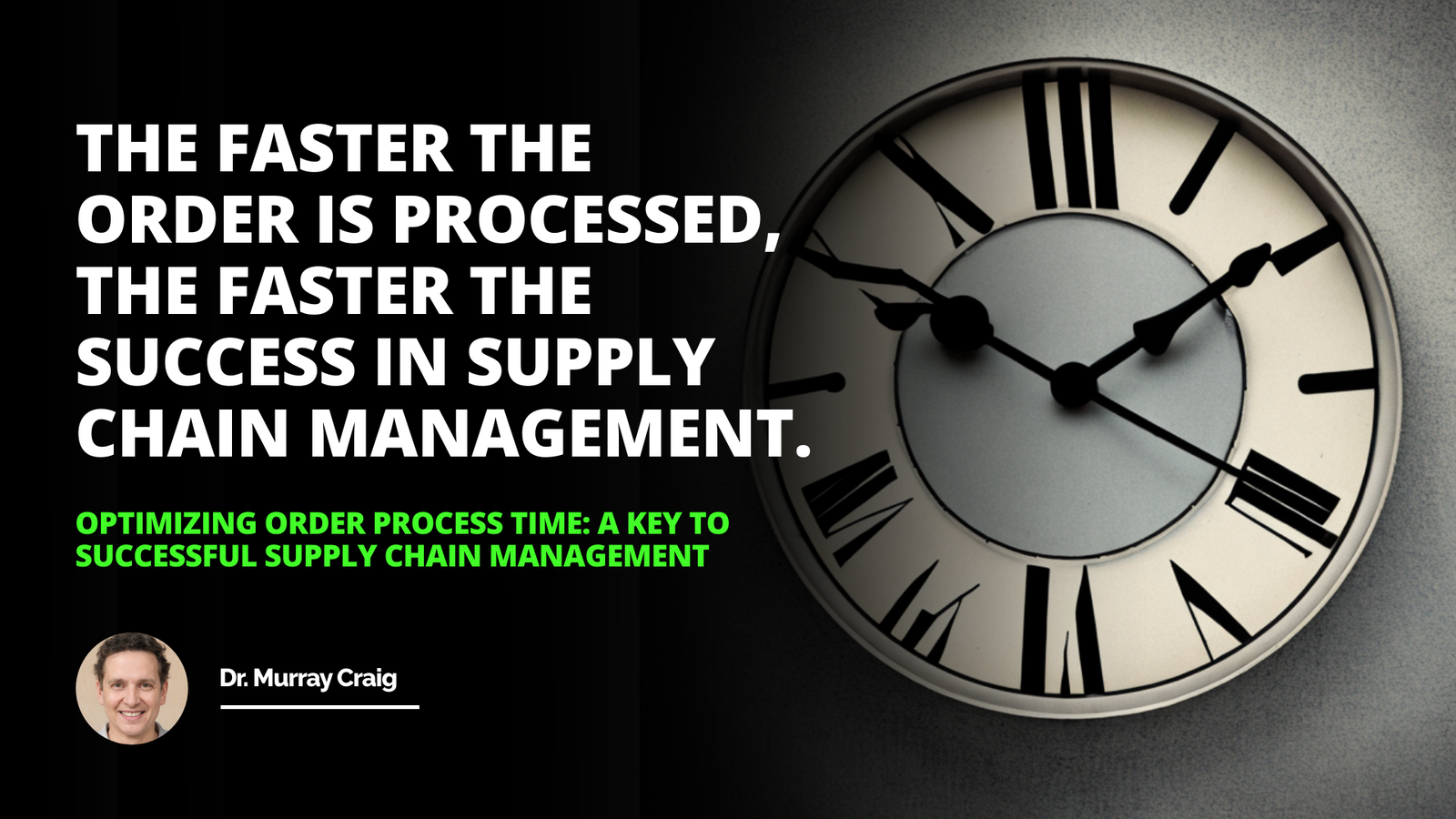
The transportation and storage of products within a temperature-controlled environment, known as cold chain logistics, are critical components of the supply chain for various temperature-sensitive goods. As the global economy expands and consumer demand for fresh and specialized products increases, the role of cold chain logistics has become more vital than ever before.
This logistic strategy is essential for maintaining the integrity and quality of perishable foods, pharmaceuticals, and biological products, among others. As industries become more regulated and technology advances, the ability of companies to efficiently manage their cold chain logistics determines their success in delivering safe and high-quality products.
This article examines the essential nature of cold chain logistics and the technological advancements that are shaping its future.
Definition and Importance of Cold Chain Logistics
Cold chain logistics is much more than transporting goods from point A to point B within a chilled environment. It represents a series of meticulously planned actions, meant to preserve the integrity and lifespan of perishable products that are sensitive to temperature variations.
In today's fast-paced economy, the importance of cold chain logistics cannot be overstated. It ensures that vaccines reach the most remote locations without losing their potency and that fresh produce maintains its nutritional value from farm to market.
The modern economy relies heavily on these logistic solutions to meet strict health and safety standards. The demand for fresh foods, the surge in biopharmaceutical products, and the increased expectation for quality all mandate efficient cold chain logistics operations. Without such systems in place, a staggering amount of product loss could be experienced, resulting in financial setbacks and health risks.
Unique to cold chain logistics is its dependence on consistent temperature control throughout the entire supply chain. Unlike other goods, temperature-sensitive products cannot endure heat spikes or freezing without risks of spoilage. The implications of not properly managing cold chain logistics, therefore, extend beyond mere financial loss; they involve concerns over public health and safety, which are paramount to maintaining consumer trust and industry standards.
The Essence of Cold Chain Logistics
Unleashing the Power of Logistics for 30-Minute Pizza Delivery
Reverse Logistics: Exploring Benefits, Challenges & Strategies
Navigating Last Mile Delivery: Advantages, Challenges & Trends
Components of Cold Chain Logistics
Inside the world of cold chain logistics, various components work in unison to create an uninterrupted cool environment for sensitive products. These range from refrigerated storage facilities to temperature-controlled transport modes such as reefers (refrigerated trucks), ships, and air cargo. Together, these components preserve the required temperature settings and ensure the efficient transfer of goods across the globe.
Every component within the cold chain has its role and function, ensuring that products remain within their required temperature ranges. For example, refrigerated warehouses store goods before and after transportation, serving as critical nodes within the supply chain. Meanwhile, the use of reefers allows for the seamless transportation of these goods over vast distances, with onboard temperature monitoring systems ensuring constant temperature control.
Managing the different elements of cold chain logistics presents inherent challenges. Ensuring that all components operate correctly requires significant investment and coordination. Any breakdown or failure in one part of the chain can lead to compromised product quality or total loss, which heightens the need for a robust logistics strategy and the implementation of redundant systems to mitigate potential failures.
Example of a Full-Scale Cold Chain Logistics System in a Major Food Retail Company
Consider, for instance, a full-scale cold chain logistics system implemented by a major food retail company. This system encompasses procurement from various suppliers, including international and local farms, all of which comply with the company's stringent cold chain requirements. The goods are transported via refrigerated trucks from farms to a central refrigerated warehousing facility, where they are stored at optimal temperatures. From here, products are dispatched to individual retail outlets, frequently monitored to ensure that temperature ranges remain consistent throughout.
In such a system, technology plays a crucial role in monitoring and maintaining the temperature of products throughout the journey. It includes temperature monitoring devices that provide real-time data, allowing the company to respond swiftly to any deviations. This seamless integration of technology within all cold chain logistics components ensures that the final consumer receives fresh produce with minimal risk of spoilage.
III. Implementing Cold Chain Logistics
Key Considerations in Implementing Cold Chain Logistics
When venturing into establishing a cold chain system, certain factors stand out as fundamental to its success. The logistics of maintaining specific temperature demands meticulous planning, substantial investment in the right infrastructure, experienced personnel, and a deep understanding of the product's specific requirements. One also must consider the logistics routes, taking into account the distance, environmental conditions, and available infrastructure en route.
Regulatory compliance is another critical factor when implementing cold chain logistics. Different countries and regions have varying regulations regarding the transportation and storage of temperature-controlled goods. Adherence to these regulations not only ensures the legality of operations but also helps maintain product integrity and customer trust.
Moreover, potential pitfalls such as equipment malfunctions, power outages, and temperature excursions must be anticipated. The ability to mitigate such risks involves having contingency plans in place, such as backup generators for refrigeration units and emergency response protocols, to minimize disruption and financial impact.
Case Study of Successful Implementation of Cold Chain Logistics in the Pharmaceutical Industry
The pharmaceutical industry provides a compelling case study of the successful implementation of cold chain logistics. Consider a multinational pharmaceutical company that has introduced various vaccines requiring stringent temperature control. Their cold chain system is designed to manage the storage, handling, and transportation processes to prevent any temperature deviations that could degrade the vaccine's effectiveness.
Throughout their logistics chain, from the manufacturing plant to the end-user, the company employs temperature-controlled packaging solutions, refrigerated transport, and cold storage warehousing. They are adept at navigating international regulations and have a logistics infrastructure that supports the seamless transfer of products across borders. They also employ sophisticated temperature monitoring devices linked to a centralized system for real-time response in case of anomalies.
This comprehensive approach ensures that vaccines remain viable and effective upon reaching their destinations. It's a testament to how thorough planning, robust implementation, and an unwavering commitment to quality can render a successful cold chain logistics operation, particularly in a field where the margin for error is virtually non-existent.
The Technological Advancements in Cold Chain Logistics
The Role of Technology in Cold Chain Logistics
Technology is revolutionizing every aspect of cold chain logistics, heralding a new age of efficiency and reliability. The digital revolution has brought forth advanced analytical tools, IoT devices, and blockchain technology, each taking cold chain logistics to higher levels of precision and transparency. These advancements facilitate real-time monitoring and data gathering, enabling logistic firms to make informed decisions swiftly.
Advances in technology also allow for the meticulous tracking of goods throughout the supply chain. GPS units, RFID tags, and temperature sensors provide stakeholders with up-to-date locations and conditions of their products. Such granular surveillance ensures immediate intervention should conditions deviate from predetermined norms, thereby preserving product integrity.
Looking ahead, technological trends such as automation and artificial intelligence promise to further impact the cold chain sector. They are predicted to enhance the efficiency of logistics operations, reduce human error, and better predict and manage the complexities associated with the maintenance of these sensitive supply chains.
Real-life Applications of Advanced Technologies in Cold Chain Logistics
The application of advanced technologies in cold chain logistics can be observed in various sectors. For instance, an American logistics company specializing in fresh food delivery utilizes IoT sensors to monitor temperature and humidity within their fleet of delivery trucks. This technology ensures that perishable goods such as fruits, vegetables, dairy, and meats are maintained at the correct temperatures, minimizing spoilage and waste.
Similarly, some vaccine distributors are now using blockchain technology to increase transparency in their cold chain. By digitizing the supply chain, they can record and verify each step of the vaccine's journey, ensuring its handling meets the highest standards. These applications not only ensure product safety and quality but also contribute significantly to customer confidence in the brands they choose.
Future Trends and Predictions in Cold Chain Logistics
This exploration of cold chain logistics reflects its inherent complexities and the critical role it plays in various industries. Looking to the future, it's expected that the demand for cold chain logistics will only grow, propelled by globalization, e-commerce, and heightened consumer expectations. As the sector evolves, we are likely to see a greater emphasis on sustainability, with companies seeking eco-friendly refrigeration solutions and optimizing logistics routes to reduce carbon footprints.
Economic trends, such as the rise in the middle-class population in developing countries, will also influence cold chain logistics, spurring further investment in infrastructure to meet the growing demand for quality products. In parallel, technological advancements will continue to refine practices, with companies increasingly relying on big data analytics, predictive algorithms, and autonomous vehicles to streamline their cold chain operations.
Advice to Companies Seeking to Optimize their Cold Chain Logistics Systems
For companies looking to optimize their cold chain logistics systems, the key takeaway is the importance of flexibility and innovation. Staying abreast of technological trends, investing in advanced monitoring tools, and continuously improving processes can provide a significant competitive edge. Moreover, fostering a culture that prioritizes the integrity of the product and the safety of the end-user is paramount.
Benchmarking against industry standards and learning from successful case studies can provide meaningful insights into best practices. By focusing on quality, regulatory compliance, and relentless pursuit of improvement in cold chain logistics, companies can ensure their continued relevance and success in an increasingly discerning and connected global market.

Frequently Asked Questions
What is the essential role of cold chain logistics in preserving the integrity of temperature-sensitive products during transportation and storage in various industries?
The Importance of Cold Chain Logistics
Cold chain logistics plays a critical role in maintaining the quality and safety of temperature-sensitive products across various industries. It ensures the integrity of these products from the point of origin to the destination.
Core Functions of Cold Chain Logistics
Protection Against Temperature Fluctuations: Cold chain logistics provides a controlled environment. It safeguards products against extreme temperatures. This protection is crucial for product efficacy and safety.
Compliance With Regulatory Standards: Many industries must adhere to strict guidelines. Cold chain logistics ensures compliance, thus avoiding legal issues and potential fines.
Extending Product Shelf Life: By maintaining optimal temperatures, cold chain logistics extends the life of perishable goods. This reduces waste and maximizes profitability.
Ensuring Consumer Safety: For consumables like food and pharmaceuticals, cold chain logistics is essential for safety. It prevents contamination and preserves vital properties.
Industries That Rely on Cold Chain Logistics
Pharmaceutical Industry: Drugs and vaccines require strict temperature control. Slight deviations can render them ineffective or harmful.
Food and Beverage: Freshness and safety in perishables depend on maintaining the cold chain. From production to retail, it is essential.
Floral Industry: Flowers are delicate and perishable. Constant temperature management preserves their beauty and value.
Chemicals: Certain chemicals demand controlled temperatures. Stability and safety rely on effective cold chain management.
Biotechnology: Research specimens and biological materials need precise temperatures. Cold chain logistics supports advances in biotechnology and medical research.
Challenges and Solutions
Cold chain logistics faces challenges such as infrastructure demands, cost management, and technological integration. Nonetheless, the industry continually evolves to overcome these issues, employing more advanced refrigeration methods, improved packaging, and real-time temperature monitoring systems. Ultimately, cold chain logistics plays an indispensable role in securing the integrity and trustworthiness of temperature-sensitive products, benefiting both industries and consumers alike.

How does the implementation of cold chain logistics contribute to reducing financial losses through minimizing product spoilage in businesses?
Cold chain logistics management stands crucial for businesses handling perishable goods. These include pharmaceuticals, food commodities, and other temperature-sensitive products. Cold chain logistics ensure that such products maintain their integrity from origin to destination. Without it, product spoilage becomes imminent. This leads to financial loss and reputational damage.
Cold Chain Logistics Explained
Cold chain logistics entails a series of refrigerated production, storage, and distribution activities. Its goal remains: maintaining a constant temperature. It comprises refrigerated warehouses and transport solutions. They help in preserving product shelf life and quality.
Minimizing Product Spoilage
The introduction of cold chain logistics helps businesses in various ways:
Maintains Product Integrity: It keeps products within their required temperature range. This preserves their usability and saleability.
Extends Shelf Life: Proper temperature control prolongs shelf life. Thus, it reduces spoilage.
Adheres to Compliance Standards: It ensures businesses meet health and safety guidelines. This prevents legal penalties which lead to financial loss.
Reducing Financial Losses
Decreases Waste: Efficient temperature control decreases the amount of product thrown out.
Optimizes Inventory Management: It allows for better rotation and utilization of stock.
Enhances Customer Satisfaction: High-quality products lead to repeat purchases.
Lowers Energy Costs: Advanced cold chain solutions are energy-efficient. They cut down on electricity costs.
The Role of Technology
Tech advancements are boosting the efficacy of cold chain logistics.
Real-Time Monitoring: IoT devices allow for constant tracking.
Predictive Analytics: This anticipates potential system failures.
Automated Controls: They adjust settings to maintain optimal conditions.
Cold chain logistics plays an essential role in modern commerce. It safeguards product quality and extends market reach. It also offers financial stability by curbing spoilage-induced losses. Businesses investing in these systems stand to gain through increased profitability and customer trust.

To what extent does the advancements in cold chain logistics technology impact the efficiency and effectiveness of overall supply chain procedures?
The Impact of Cold Chain Advances
Cold chain logistics are vital. They ensure sensitive goods stay fresh. Their efficient management is crucial. It becomes more so as global trade grows. Recent technological advances have transformed this sector significantly.
Enhanced Monitoring Powers Efficiency
Firstly, real-time tracking has improved immensely. Sensors now monitor temperature meticulously. They thus ensure product integrity throughout transit. This tracking includes humidity and location data. Supply chain visibility increases. Decisions become data-driven. Efficiency naturally follows suit.
Automation Reduces Human Error
Automation is another key leap forward. Manual intervention has its limits. It often introduces errors. Automated systems, however, streamline processes. They standardize handling procedures. Result? Greater consistency, fewer mistakes. The supply chain becomes more reliable. Confidence in product quality grows.
Data Analytics Drive Decisions
Data analytics play a crucial role. They harness vast amounts of information. Insights from this data guide operations. They enable predictive maintenance. They also help optimize routes. Supply chains become smarter. They adapt to changing conditions swiftly.
Sustainability Benefits Business
Cold chain technologies now focus on sustainability. More efficient refrigeration systems are in place. They use less energy. Packaging advances reduce waste. Overall, this lowers the carbon footprint. Such improvements appeal to eco-conscious consumers. They can also lower operating costs.
Packaging Innovations Enhance Protection
Next, consider packaging innovations. They have advanced protective qualities. These reduce spoilage. They extend the viability of goods. They allow for longer journeys. This expands market reach. It also minimizes losses. The bottom line looks better.
Compliance Made Simpler
Regulatory compliance is a complex aspect. Cold chain technology eases this burden. It ensures standards are met effortlessly. Tracking systems confirm proper handling. Reports are generated automatically. This safeguards against legal issues. It also maintains customer trust.
Conclusion: Technology as a Catalyst
In summary, cold chain logistics technology transforms the supply chain. Monitoring, automation, analytics, sustainability, and packaging have all progressed. They have heightened the effectiveness and efficiency of the supply chain. They meet growing demands. They do so while maintaining product quality. Supply chains now respond faster. They adapt to market changes effortlessly. They do this all while controlling costs. Thus, the extent of impact? Significant, to say the least.



